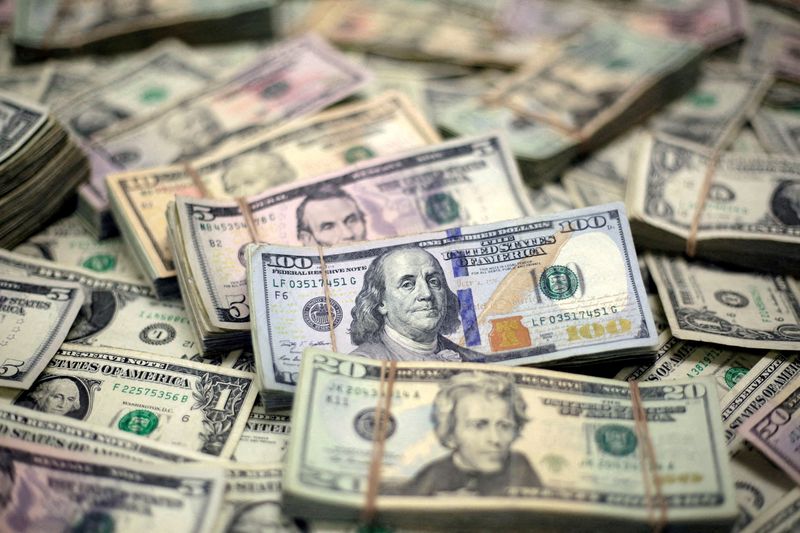By Kevin Buckland
TOKYO (Reuters) -The dollar hovered close to a three-month peak on Wednesday in a big week for macroeconomic data that could reveal the path for U.S. monetary policy.
The Australian dollar slipped to a three-month trough after some stickiness in inflation suggested a Reserve Bank of Australia interest rate cut is unlikely this year.
Mixed U.S. indicators overnight, showing a loosening U.S. jobs market but a confident consumer, provided little clarity on the outlook for Federal Reserve easing, allowing the greenback to drift lower with Treasury yields on Tuesday following a strong seven-year note auction.
Recently though, economic readings have pointed to a resilient economy, particularly for employment, spurring a paring back of bets on the pace of rate reductions. The ADP employment report is due later in the day, ahead of the potentially crucial monthly payrolls report on Friday.
“The U.S. dollar continues to garner strong support as markets adjust their rate path expectations,” said James Kniveton, senior corporate FX dealer at Convera.
“The American economy is currently firing on all cylinders.”
Meanwhile in Australia, “the increased inflation number in services is likely to mean rate reductions this year are a very distant prospect,” Kniveton said.
The Reserve Bank of Australia’s preferred inflation gauge, the trimmed mean measure, slowed to 3.5% from 4.0% in the third quarter, but service-sector inflation remained elevated. On a quarterly basis, the gauge increased by 0.8%, topping forecasts for a 0.7% rise.
The Aussie dropped as low as $0.6537 for the first time since Aug. 8, before trading 0.27% weaker at $0.6542 at 0531 GMT.
The U.S. dollar index, which measures the currency against six major rivals including the yen and euro, was little changed at 104.28, after reaching the highest since July 30 at 104.63 on Tuesday before finishing the day almost flat.
The 10-year Treasury yield slid to 4.2482% on Wednesday, after reaching the highest since July 5 at 4.3390% in the prior session.
Both the dollar and U.S. bond yields have also been buoyed in recent days by rising speculation in markets and on some betting platforms for a victory on Nov. 5 for Republican presidential candidate Donald Trump, whose tariff and immigration policies are seen as inflationary.
That also helped leading cryptocurrency bitcoin surge to near its all-time high from March at $73,803.25, as Trump has vowed to make the United States “the crypto capital of the planet.” The token last changed hands at about $72,477, after pushing as high as $73,609.88 in the previous session.
Opinion polls still indicate the presidential race is too close to call.
“The weight of capital (has been) moving to push Trump’s odds in the betting markets to a new high implied, although many remain conditioned to see this more as noise and less of a signal,” said Chris Weston, head of research at Pepperstone.
At the same time, “the idea of owning crypto – and gold – to hedge out ongoing fiscal recklessness and debasement remains very much present, but this ‘investment’ thesis has morphed into an out-and-out momentum trade,” Weston said.
Gold rose to a fresh all-time high of $2,782.78 per ounce on Wednesday.
The dollar-yen pair, which tends to track U.S. yields closely, slipped 0.08% to 153.26, after retreating from a three-month peak of 153.87 on Tuesday.
The yen has also been weighed down by political uncertainty since a disastrous weekend election for Japan’s ruling coalition resulted in it losing its majority in parliament, ushering in a period of horse trading that is likely to result in expanded fiscal spending and could potentially delay rate hikes.
The Bank of Japan is widely expected to hold policy steady on Thursday, although analysts are divided over the prospect of additional tightening by the year-end.
The euro was flat at $1.0815 ahead of gross domestic product readings across Europe later in the day, which could shed light on whether the European Central Bank will opt to cut rates by 25 or 50 basis points at its next meeting in December.
Sterling traded down 0.12% at $1.29995 ahead of the Labour government’s first budget on Wednesday.
Finance Minister Rachel Reeves, along with Prime Minister Keir Starmer, has reiterated the need for tough fiscal measures to help close a hole in British public finances. They are seeking to retain the confidence of investors, two years after then-Prime Minister Liz Truss’ tax-cutting plans sparked a crisis in the bond market.
Key for sterling will be estimates from the UK’s Office for Budget Responsibility, which makes the forecasts that underpin the government’s spending and tax plans.

